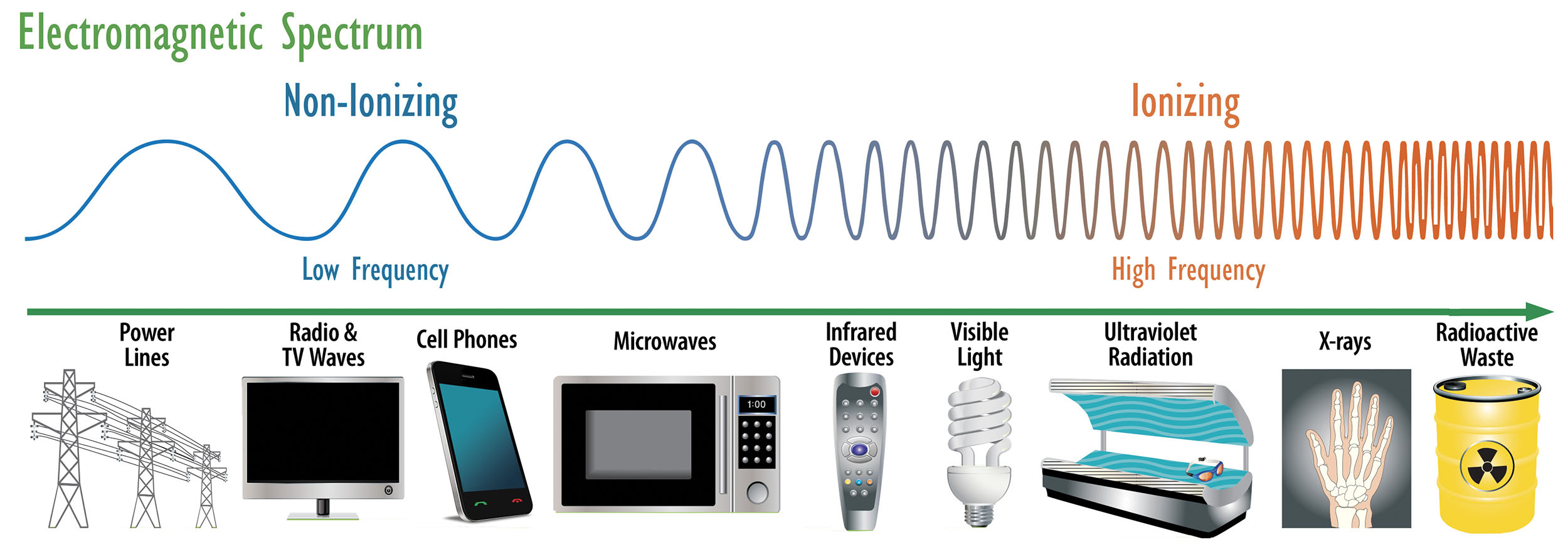Introduction

Electric and magnetic fields (EMFs) are invisible areas of energy, often referred to as Radiation, that are associated with the use of electrical power and various forms of natural and man-made lighting. EMFs are typically grouped into one of two categories by their frequency:
- Non-ionizing: low-level radiation which is generally perceived as harmless to humans
- Ionizing: high-level radiation which has the potential for cellular and DNA damage
| Radiation Type | Definition | Forms of Radiation | Source Examples |
|---|---|---|---|
| Non-Ionizing | Low to mid-frequency radiation which is generally perceived as harmless due to its lack of potency. |
|
|
| Ionizing | Mid to high-frequency radiation which can, under certain circumstances, lead to cellular and or DNA damage with prolonged exposure. |
|
|
Can EMFs be harmful to my health?
During the 1990s, most EMF research focused on extremely low frequency exposures stemming from conventional power sources, such as power lines, electrical substations, or home appliances. While some of these studies showed a possible link between EMF field strength and an increased risk for childhood Leukemia, their findings indicated that such an association was weak. The few studies that have been conducted on adults show no evidence of a link between EMF exposure and adult cancers, such as leukemia, brain cancer, and breast cancer.
Now, in the age of cellular telephones, wireless routers, and the Internet of things, all of which use EMF, additional research is needed on practical ways to reduce exposures to EMFs.
Does my cell phone emit EMF radiation?
Cell phones emit a form of radio frequency radiation at the lower end of the non-ionizing radiation spectrum. Currently, scientific evidence has not conclusively linked cell phone use with any adverse human health problems.
The National Toxicology Program (NTP), headquartered at NIEHS, conducted toxicology studies in rats and mice to help clarify potential health hazards, including cancer risk, from exposure to radio frequency radiation like that used in 2G and 3G cell phones. Please visit the Cell Phone Radio Frequency Radiation webpage to learn more.
What if I live near a power line?
It is important to remember that the strength of a magnetic field decreases dramatically with increasing distance from the source. This means that the strength of the field reaching a house or structure will be significantly weaker than it was at its point of origin.
For example, a magnetic field measuring 57.5 milligauss immediately beside a 230 kilovolt transmission line measures just 7.1 milligauss at a distance of 100 feet, and 1.8 milligauss at a distance of 200 feet, according to the World Health Organization in 2010.
For more information, see the NIEHS educational booklet, “EMF: Electric and Magnetic Fields Associated with the Use of Electric Power”.
What is NIEHS Doing?
NIEHS Research Efforts
- NIEHS Report on Health Effects from Exposure to Power-Line Frequency Electric and Magnetic Fields: Prepared in Response to the 1992 Energy Policy Act (PL 102-486, Section 2118) (751KB) - Prepared in Response to the 1992 Energy Policy Act (PL 102-486, Section 2118)
Further Reading
Additional Resources
- Electromagnetic Fields and Cancer - National Cancer Institute
- IARC Classifies Radiofrequency Electromagnetic Fields as Possibly Carcinogenic to Humans - The WHO/International Agency for Research on Cancer (IARC) has classified radio frequency electromagnetic fields as possibly carcinogenic to humans (Group 2B), based on an increased risk for glioma, a malignant type of brain cancer1, associated with wireless phone use.
- Radiofrequency Background - U.S. Food and Drug Administration
- RadTown - Learn about radiation in your town: where it is and how it's used. Explore the Burbs, Countryside, Downtown or Waterfront. Just pick and click! From the U.S. Environmental Protection Agency
- Workplace Safety and Health Topics: EMF (ELECTRIC AND MAGNETIC FIELDS) - The National Institute for Occupational Safety and Health (NIOSH)
Related Health Topics
This content is available to use on your website.
Please visit NIEHS Syndication to get started.


